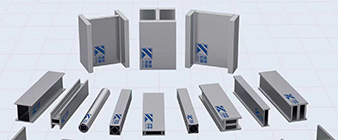The transition from S460 steel to S690 steel involves several key differences in performance, applications and benefits. Here is a comparison of the two levels:
Yield Strength
S460 steel: minimum yield strength is 460 MPa.
S690 steel: minimum yield strength is 690 MPa.
Significance: S690 steel has significantly higher strength, allowing for reduced material use and lighter structures.
Tensile Strength
S460 steel: Tensile strength typically 510 to 620 MPa.
S690 steel: tensile strength range from 780 to 900 MPa.
Significance: S690 has higher tensile strength to provide better performance under extreme load conditions.
Extensibility
S460 steel: generally has good ductility and is suitable for a variety of applications.
S690 Steel: While still ductile, S690 may elongate less than S460, especially in thicker sections.
Significance: For applications where ductility is critical, design considerations may be necessary.
Weldability
S460 steel: Good weldability, standard welding techniques can be used.
S690 Steel: Due to its higher strength, careful welding practices are required; preheating and post-weld heat treatment may be required.
Significance: Design and manufacturing processes need to consider welding techniques to ensure structural integrity.
Application
S460 Steel: Commonly used in buildings, bridges, and general structural applications.
S690 Steel: Ideal for high-strength applications such as high-rise buildings, heavy machinery and bridge components requiring high load-bearing capacity.
Significance: S690 is the first choice for projects requiring higher performance and efficiency.
Cost
S460 Steel: Generally less expensive due to lower strength requirements.
S690 Steel: Higher cost due to advanced material properties and processing.
Significance: While the upfront cost of the S690 may be higher, there are savings in material and construction costs due to reduced weight and material usage.
Sustainability
Both grades: S460 and S690 are recyclable and contribute to sustainable building practices.
Significance: Using high-strength steels such as S690 allows for more efficient designs and reduced environmental impact.
Transitioning from S460 steel to S690 steel can provide significant advantages in strength and material efficiency, making S690 suitable for demanding applications. However, during the design and construction process, considerations of weldability, ductility, and cost are critical.
-
 2024-9-21 High strength S690 steel VS 960 steel
2024-9-21 High strength S690 steel VS 960 steel -
 2024-9-15 Introduction to the performance of 1.4301/1.4307 stainless steel
2024-9-15 Introduction to the performance of 1.4301/1.4307 stainless steel -
 2024-9-20 2507 super duplex stainless steel in nuclear power of innovative applications
2024-9-20 2507 super duplex stainless steel in nuclear power of innovative applications -
 2024-1-31 Introduction to stainless steel I-beam
2024-1-31 Introduction to stainless steel I-beam -
 2024-9-21 S690Q/S690QL/S690QL1 in Hong Kong construction engineering of Advantages
2024-9-21 S690Q/S690QL/S690QL1 in Hong Kong construction engineering of Advantages -
 2024-7-10 S960Q/S960QL/S960QL Steel Welding
2024-7-10 S960Q/S960QL/S960QL Steel Welding -
 2024-9-25 Application of 1.4404 stainless steel structural profiles in civil engineering
2024-9-25 Application of 1.4404 stainless steel structural profiles in civil engineering



